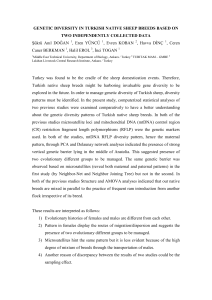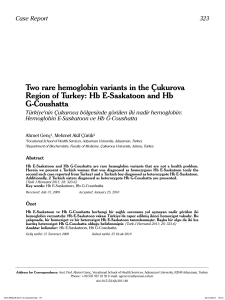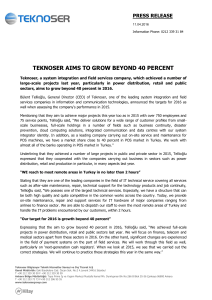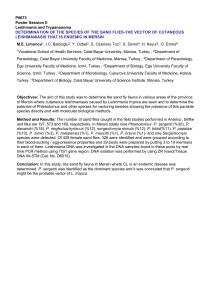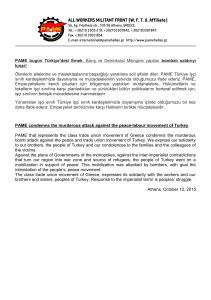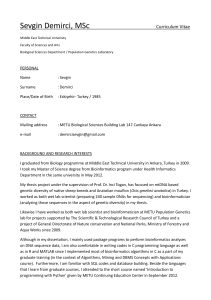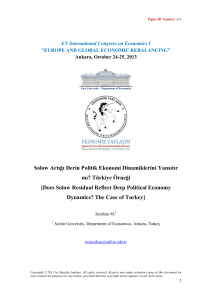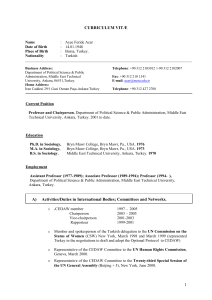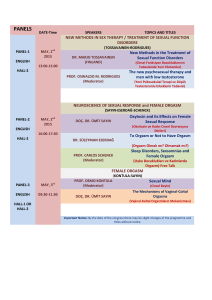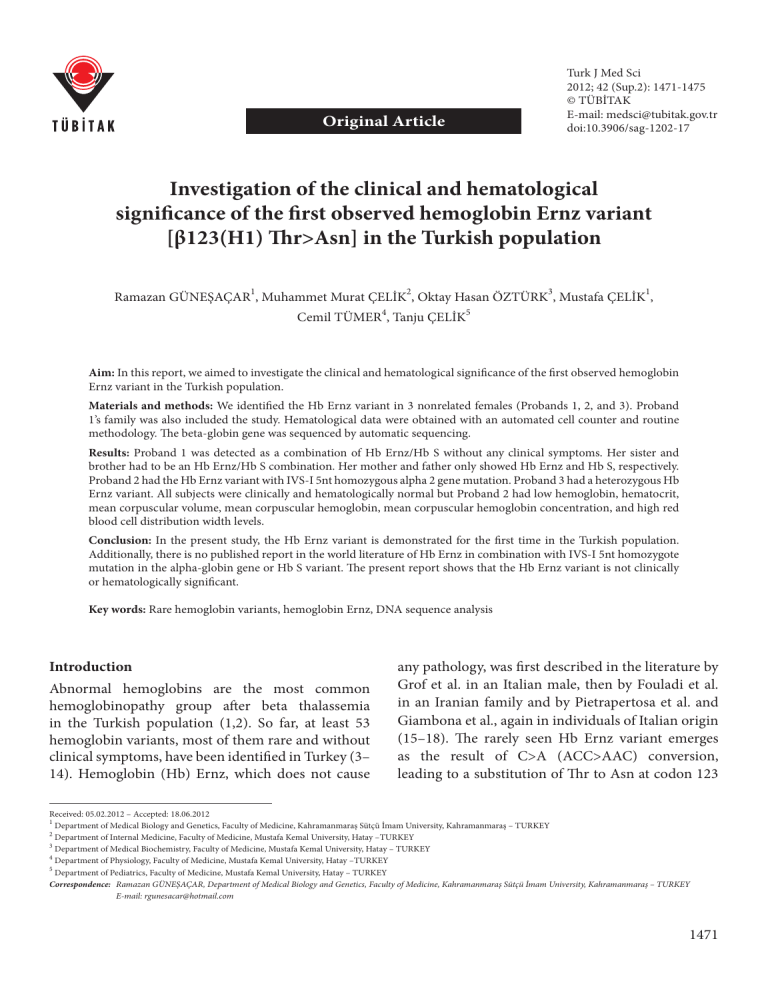
Original Article
Turk J Med Sci
2012; 42 (Sup.2): 1471-1475
© TÜBİTAK
E-mail: [email protected]
doi:10.3906/sag-1202-17
Investigation of the clinical and hematological
significance of the first observed hemoglobin Ernz variant
[β123(H1) Thr>Asn] in the Turkish population
Ramazan GÜNEŞAÇAR1, Muhammet Murat ÇELİK2, Oktay Hasan ÖZTÜRK3, Mustafa ÇELİK1,
Cemil TÜMER4, Tanju ÇELİK5
Aim: In this report, we aimed to investigate the clinical and hematological significance of the first observed hemoglobin
Ernz variant in the Turkish population.
Materials and methods: We identified the Hb Ernz variant in 3 nonrelated females (Probands 1, 2, and 3). Proband
1’s family was also included the study. Hematological data were obtained with an automated cell counter and routine
methodology. The beta-globin gene was sequenced by automatic sequencing.
Results: Proband 1 was detected as a combination of Hb Ernz/Hb S without any clinical symptoms. Her sister and
brother had to be an Hb Ernz/Hb S combination. Her mother and father only showed Hb Ernz and Hb S, respectively.
Proband 2 had the Hb Ernz variant with IVS-I 5nt homozygous alpha 2 gene mutation. Proband 3 had a heterozygous Hb
Ernz variant. All subjects were clinically and hematologically normal but Proband 2 had low hemoglobin, hematocrit,
mean corpuscular volume, mean corpuscular hemoglobin, mean corpuscular hemoglobin concentration, and high red
blood cell distribution width levels.
Conclusion: In the present study, the Hb Ernz variant is demonstrated for the first time in the Turkish population.
Additionally, there is no published report in the world literature of Hb Ernz in combination with IVS-I 5nt homozygote
mutation in the alpha-globin gene or Hb S variant. The present report shows that the Hb Ernz variant is not clinically
or hematologically significant.
Key words: Rare hemoglobin variants, hemoglobin Ernz, DNA sequence analysis
Introduction
Abnormal hemoglobins are the most common
hemoglobinopathy group after beta thalassemia
in the Turkish population (1,2). So far, at least 53
hemoglobin variants, most of them rare and without
clinical symptoms, have been identified in Turkey (3–
14). Hemoglobin (Hb) Ernz, which does not cause
any pathology, was first described in the literature by
Grof et al. in an Italian male, then by Fouladi et al.
in an Iranian family and by Pietrapertosa et al. and
Giambona et al., again in individuals of Italian origin
(15–18). The rarely seen Hb Ernz variant emerges
as the result of C>A (ACC>AAC) conversion,
leading to a substitution of Thr to Asn at codon 123
Received: 05.02.2012 – Accepted: 18.06.2012
1
Department of Medical Biology and Genetics, Faculty of Medicine, Kahramanmaraş Sütçü İmam University, Kahramanmaraş – TURKEY
2
Department of Internal Medicine, Faculty of Medicine, Mustafa Kemal University, Hatay –TURKEY
3
Department of Medical Biochemistry, Faculty of Medicine, Mustafa Kemal University, Hatay – TURKEY
4
Department of Physiology, Faculty of Medicine, Mustafa Kemal University, Hatay –TURKEY
5
Department of Pediatrics, Faculty of Medicine, Mustafa Kemal University, Hatay – TURKEY
Correspondence: Ramazan GÜNEŞAÇAR, Department of Medical Biology and Genetics, Faculty of Medicine, Kahramanmaraş Sütçü İmam University, Kahramanmaraş – TURKEY
E-mail: [email protected]
1471
Hemoglobin Ernz in the Turkish population
in the third exon of the β-globin gene. This variant
cannot be identified with common electrophoretic
techniques such as cellulose acetate electrophoresis,
which is carried out in alkali and acidic pH and
high-performance liquid chromatography (HPLC).
The present study is the first to report the Hb Ernz
variant in the Turkish population as well as the
Hb Ernz variant in combination with an IVS-I 5nt
homozygote mutation in the alpha-globin gene or Hb
S variant in the world literature.
Materials and methods
A total of 7 individuals, including a 30-year-old
female (Proband 1) who presented to the Mustafa
Kemal University Medical Faculty, Department
of Medical Biology and Genetics, for premarital
screening of thalassemia mutations, her parents and
2 siblings, and 2 females aged 26 and 32 who had
no familial relationship (Probands 2 and 3), were
included in the study. Written informed consent
was taken from the individuals. Hematological data
from the subjects were obtained via an automated
cell counter and routine methodology. Red cell
lysates were analyzed by HPLC (Tosoh Bioscience
Inc., San Francisco, CA, USA) and cellulose acetate
electrophoresis at alkaline pH (Interlab, Milano,
Italy). Genomic DNA was isolated from leukocytes
using a standard salting out procedure, as described
Miller et al. (19). PCR amplifications of the β-globin
gene in 2 separate tubes were performed with forward
and reverse primers and amplified products were
sequenced using an ABI PRISM BigDye Terminator
Cycle Sequencing Ready Reaction Kit (Applied
Biosystems, Foster City, CA, USA), according to the
manufacturer’s instructions. The sequence reaction
was analyzed using an automated fluorescencebased DNA sequence analyzer (ABIPRISM 3130,
Applied Biosystems). The mutation was confirmed
via sequencing of the antisense DNA strand, which
was performed twice. Mutations of the alpha-globin
gene were identified using a strip assay kit based on
the reverse hybridization technique (ViennaLab,
Austria).
Results
In the present study, Proband 1, her sister, and her
brother were found to have a combined heterozygous
genotype of Hb Ernz/Hb S. In addition, her mother
was heterozygous in the Hb Ernz and her father in the
Hb S genotype. No clinical pathologic symptom was
defined in the whole family. Hematologic data of the
Hb Ernz family are shown in the Table and the DNA
sequence electropherogram of the Hb Ernz genotype
is shown in Figure 1. The Hb Ernz variant could
not be identified in cellulose acetate electrophoresis
carried out at alkali pH (Figure 2).
In addition to being heterozygous in the Hb Ernz
genotype, Proband 2 carried an Hb Ernz variant
with IVS-I 5nt homozygous alpha 2 gene mutation.
The Hb (8.7 g/dL), hematocrit (Hct) (27.3%),
Kodon 123 C>A
(ACC>AAC)
1
2
3
4
5
6
7
+
-
Figure 1. DNA sequence electropherogram of Hb Ernz (β123,
ACC>AAC).
1472
Figure 2. Hemoglobin electrophoresis analysis at alkaline pH
of Proband 1 and her family members, Proband 2,
and Proband 3. Lane 1, Proband 1’s mother; lane 2,
Proband 1’s father; lane 3, Proband 1; lanes 4 and 5,
Proband 1’s sister and brother; lanes 6 and 7, Proband
2 and 3, respectively.
Hb Ernz/Hb A
Hb S/Hb A
Hb Ernz/Hb S
Hb Ernz/Hb S
Hb Ernz/Hb S
Mother
Father
Proband 1
Sister
Brother
Genotype
12.4
12.1
12.5
11.9
13.0
Hb
(g/dL)
36.1
35.3
35.5
34.8
38.0
Hct
(%)
77.4
76.2
77.1
76.4
84.9
MCV
(fL)
27.0
28.1
27.2
28.0
29.7
MCH
(pg/dL)
32.2
33.6
35.2
34.8
34.3
MCHC
(g/dL)
14.0
14.3
15.7
16.8
15.1
RDW
(%)
42.9
39.3
44.9
44.3
80.2
Hb A1 or
Hb Ernz (%)
Table. Hemoglobin genotypes and hematologic values of Hb Ernz family.
4.4
3.8
4.3
3.9
1.8
Hb A2
(%)
1.33
1.81
1.57
1.41
0.72
Hb F
(%)
38.3
41.3
40.9
39.6
0.00
Hb S
(%)
R. GÜNEŞAÇAR, M. M. ÇELİK, O. H. ÖZTÜRK, M. ÇELİK, C. TÜMER, T. ÇELİK
1473
Hemoglobin Ernz in the Turkish population
mean corpuscular volume (MCV) (59.2 fL), mean
corpuscular hemoglobin (MCH) (18.9 pg), and mean
corpuscular hemoglobin concentration (MCHC)
(31.9 g/dL) values of Proband 2 were low and her red
blood cell distribution width (RDW) value was high
(33.8%), while the counts of erythrocytes, leukocytes,
and platelets were in the normal range. In addition,
Hb A1 was defined as 75.7%, Hb A2 as 1.7%, and Hb F
as 1.9% in HPLC assay. Proband 3 had a heterozygous
Hb Ernz variant and her hematologic values were
found to be completely in the normal range.
Discussion
Turkey is located where Asia, Africa, and Europe
are closest to each other and in a geographic region
in which Asia and Europe are connected. A wide
range of Hb variants has been identified in Turkey
since it has hosted many civilizations during its
history. Abnormal Hb variants resulting from the
change in amino acids on the globin chain, including
those in the Hb molecule, are the most common
hemoglobinopathy groups after β-thalassemia in
Turkey. A recent study from Turkey suggested that
the number of variant hemoglobins is higher than
expected (1). Altay et al. reported 42 Hb variants
found in the Turkish population as of 2002 (3). In
the following 9 years that number reached 53 by
the addition of new variants named Hb Setif (4),
Hb Pyrogos (5), Hb Volga (6), Hb Tyne (7), Hb A2
Yialousa (8), Hb Bronovo (9), Hb J-Meerut (10), Hb
Yaizu (11), Hb D-Ouled Rabah (12), Hb Tunis (13),
and Hb Crete (14).
The Hb Ernz variant is rarely seen and cannot be
identified with classical electrophoretic techniques. It
was identified by a DNA sequence analysis method
in our patients. Reporting these cases is important,
because it is the first time that the Hb Ernz variant
was reported in Turkey, and this variant was again
confirmed not to cause any clinical pathology.
Proband 1, her sister, and her brother had Hb Ernz/
Hb S genotype with low levels of MCV and Hb A1,
but high levels of Hb A2, whereas the mother, who
was heterozygous for Hb Ernz, had levels of MCV, Hb
A1, and Hb A2 in the normal range, demonstrating
that decreased MCV and elevated Hb A2 result from
HbS and not from the Hb Ernz variant. Levels of
Hb, Hct, MCV, MCH, and MCHC are known to be
1474
usually within the normal range, or slightly lower, in
alpha thalassemia carriers (20). Therefore, Proband
2, who carried the Hb Ernz variant with IVS-I 5nt
homozygous alpha 2 gene mutation, had low values
of Hb, Hct, MCV, MCH, and MCHC, which again
resulted from having an alpha-globin gene mutation
and not from the Hb Ernz variant. For this reason,
our findings indicate that Hb Ernz is a silent Hb
variant not causing any pathology.
Various Hb variants have been reported in Turkey,
which contains many migration paths due to its
geographic location. One reason for this diversity is
that Turkey was a major transit point on the historical
Silk Road that started in Italy and ran to China,
passing through Iran. We detected the Hb Ernz
variant in Antakya (Antioch), which is located on the
Mediterranean coast and known to have been a point
on the Silk Road in the medieval era, supporting our
hypothesis. However, the registration system with
regard to Hb variants found in Turkey is inadequate,
suggesting the number of variants is, in fact, greater
than we are aware of. One of the reasons why the
number of Hb variants in the Turkish population
cannot be defined to a more accurate value is that
some variants cannot be identified with screening
tests such as HPLC or electrophoresis or by screening
only the commonly seen mutations. Hb Ernz, which
we found in Turkey for the first time, is one such
variant, and it can only be detected by DNA sequence
analysis. Therefore, we believe that DNA sequence
analysis must be performed in patients suspected of
hemoglobinopathy based on hematological tests and
who could not be diagnosed with either biochemical
tests, such as HPLC and electrophoresis, or with
molecular systems screening a limited number of
mutations.
Our study is important in terms of being the first to
report the Hb Ernz variant in the Turkish population
as well as the Hb Ernz variant in combination
with IVS-I 5nt homozygote mutation in the alphaglobin gene or Hb S variant in the world literature.
In summary, our results may be a guiding factor in
the decision-making process in genetic counseling.
Demonstrating the Hb Ernz variant for the first
time in Turkey may also be helpful in providing
a contribution to the establishment of a national
database of Hb variants.
R. GÜNEŞAÇAR, M. M. ÇELİK, O. H. ÖZTÜRK, M. ÇELİK, C. TÜMER, T. ÇELİK
References
1. Keser İ, Yeşilipek A, Canatan D, Lüleci G. Abnormal
hemoglobins associated with the beta-globin gene in Antalya
province, Turkey. Turk J Med Sci 2010; 40: 127–31.
12. Köseler A, Bahadır A, Koyuncu H, Atalay A, Atalay AÖ. First
observation of Hb D-Ouled Rabah [beta19(B1)Asn>Lys] in
the Turkish population. Turk J Hematol 2008; 25: 51–3.
2. Keser İ, Manguoğlu E, Güzeloğlu Kayışlı Ö, Kurt F, Mendilcioğlu
İ, Şimşek M et al. Prenatal diagnosis of β thalassemia in the
Antalya province. Turk J Med Sci 2005; 35: 251–3.
13. Köseler A, Koyuncu A, Öztürk O, Bahadır A, Demirtepe S,
Atalay A et al. First observation of Hb Tunis [beta124(H2)
Pro>Ser] in Turkey. Turk J Hematol 2010; 27: 120–2
3. Altay Ç. Abnormal hemoglobins in Turkey. Turk J Hematol
2002; 19: 63–74.
4. Dinçol G, Elam D, Kutlar A, Kutlar F. Hb Setif [alpha94(G1)
Asp→Tyr (alpha2)] detected in a Turkish family. Hemoglobin
2003; 27: 249–52.
14. Arslan Ç, Kahraman S, Özsan H, Akar N. First observation of
hemoglobin Crete (ß129 (H7)Ala>Pro) in Turkish population.
Turk J Hematol 2011; 28: 346–7.
5. Akar E, Tunç Ş, Arcasoy A, Akar N. First observation
of hemoglobin Pyrgos [ß83(EF7) Gly→Asp] in Turkish
population. Turk J Hematol 2003; 20: 161–2.
6. 7. Sozen M, Karaaslan C, Oner R, Gumruk F, Ozdemir MA, Altay
C et al. Severe hemolytic anemia associated with Hb Volga
[beta27(B9)Ala-->Asp]: GCC-->GAC at codon 27 in a Turkish
family. Am J Hematol 2004; 76: 378–82.
Kayışlı ÖG, Keser İ, Özeş ON, Canatan D, Yeşilipek A, Lüleci
G. Compound heterozygosity for two beta chain variants: the
mildly unstable Hb Tyne (CD 5 PRO → SER) and HbS (CD6
GLU → VAL). Turk J Hematol 2005; 22: 37–40.
8. Bouva MJ, Harteveld CL, Delft P, Giordano PC. Known
and new delta globin gene mutations and their diagnostic
significance. Haematologica 2006; 91: 129–32.
9. Harteveld CL, Steen G, Vlasveld LT, van Delft P, Giordano
PC. Hb Bronovo, a new globin gene mutation at alpha2 103
(His→Leu) associated with an alpha thalassemia phenotype.
Haematologica 2006; 91: 570–1.
10. Dinçol G, Güvenç S, Elam D, Kutlar A, Kutlar F. Hb J-Meerut
[α 120 (H3) Ala ->Glu (α1)] in a Turkish male. Int J Med Sci
2006; 3: 26–7.
15. Groff P, Kalmes G, Golinska B, Miyazaki A, Riou J, Carte N. Hb
Ernz [beta123(H1)Thr>Asn] and Hb Renert [beta133(H11)
Val-->Ala]: two new neutral variants revealed by reversed
phase high performance liquid chromatography analysis.
Hemoglobin 2000; 24: 287–97.
16. Fouladi P, Fahim A, Ghahremani A, Lotfi V, Sajedi Far MM,
Vahidi R et al. Observation of Hb Ernz [β(123)Thr-->Asn] for
the first time in Iran. Eur J Hum Genet 2007; 15 (Suppl 1): 91.
17. Pietrapertosa AC, Campanale D, Mastrorilli A, Vitucci A,
Palma A. HB Ernz [Beta123(H1)Thr->Asn]: a case report.
Haematologica 2008; 93 (Suppl 2): S57.
18. Giambona A, Passarello C, Vinciguerra M, Li Muli R, Teresi P,
Anza M. Significance of borderline hemoglobin A2 values in
an Italian population with a high prevalence of ß-thalassemia.
Haematologica 2008; 93: 1380–4.
19. Miller, SA, Dykes DD, Polesky HF. A simple salting out
procedure for extracting DNA from human nucleated cells.
Nucleic Acids Res 1988; 16: 1215.
20. Ben EJ. Disorders of hemoglobin. In: Fauci AS, Braunwald E,
Kasper DL, Hauser SL, Longo DL, Jameson JL et al., editors.
Harrison’s principles of internal medicine, 17th ed. New York:
McGraw Hill; 2008. p.635–43.
11. Atalay EÖ, Atalay A, Koyuncu H, Öztürk O, Köseler A, Özkan
A et al. Rare hemoglobin variant Hb Yaizu observed in Turkey.
Med Princ Pract 2008; 17: 321–4
1475

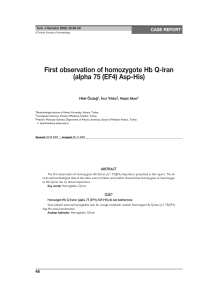
![First observation of Hb D-Ouled Rabah [beta19(B1)Asn>Lys] in the](http://s1.studylibtr.com/store/data/003346881_1-fc6465a17750760535fb52bbef4ddf81-300x300.png)
